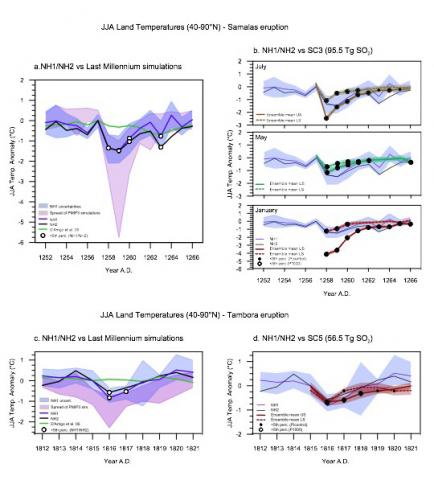Project 2 (WP2) : Volcanism during the last millenium
Project leads: Myriam Khodri, Marion Marchand
Post-doctoral researcher: Virginie Poulain
Project start/end: September 2013 – August 2015
The impact of large volcanic eruptions on the stratosphere and climate lies in principle among the potential predicable features of climate after volcanic eruption took place. However such predictability is hindered by several knowledge gaps in the aerosol emission and in the climate response. The microphysical model (Bekki et al, 1994) was first improved against observations (CCMI, satellite observations; balloons, etc) and the computed aerosols radiative properties were implemented in the IPSL model solar spectral bands. An ensemble simulation was performed for major past eruptions (Mt Pinatubo, Samalas, Tambora), using ice-core data to produce realistic scenarios of SO2 injection into the stratosphere. The uncertainties related to the season of eruption and the altitude of the volcanic plumes deduced from geological evidences were also explored, using dendro-climatological data, historical documents, and improved temperature reconstructions for the last 1500 years. For the first time, tree-ring proxies and climate simulations yield similar magnitudes for northern hemisphere summer cooling over land induced by these eruptions, estimated between –0.8 and –1.3°C. This challenges earlier climate simulations of these eruptions impacts. Results reveal that there is no universal linear relationship between the global cooling and the magnitude of the eruptions due to self-limiting microphysical processes and stratospheric dynamics impacting the main modes of climate variability. These processes explain the relatively weak cooling on global average that never exceeds 2°C for the very large eruptions and the strong spatial heterogeneity of temperature anomalies. We aim now at providing thorough forcing reconstructions for major volcanic eruptions (13th and 19th century) and contribute to the on-going effort to reduce the large uncertainties regarding the climatic responses in climate models.
Position offer and results (January 2017 update)
Figure 1 :
Summer cooling induced by the 1257 Samalas eruption as reconstructed in the tree-ring records (NH1, NH2), D’Arrigo20064, (a) PMIP3 Last Millennium simulations and by (b) the mean SO2 yield scenario (SC2 = 137.8 Tg) in the IPSL model and for eruptions in May 1257, July 1257 and January 1258. LS and US indicate the lower and upper scenarios for injection heights and correspond to 70% of the mass injected to 26–33 and 36–43 km, respectively. (c) and (d) same as (a) and (b) but for the 1815 Tambora eruption.

